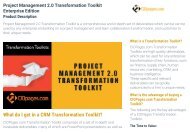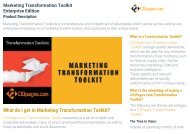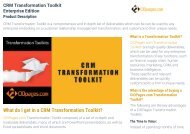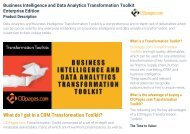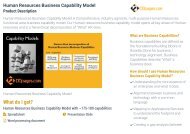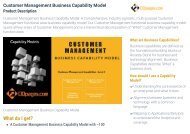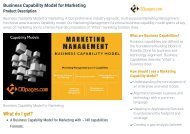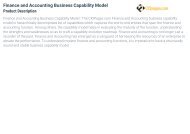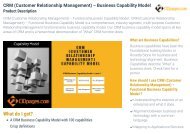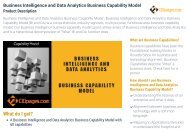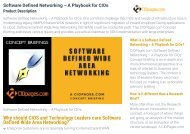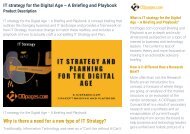Supply Chain Business Capability Model
A Comprehensive, industry-agnostic, multi-purpose Supply Chain Management functional area business capability model. Visit: https://www.ciopages.com/store/supply-chain-management-business-capability-model/
A Comprehensive, industry-agnostic, multi-purpose Supply Chain Management functional area business capability model. Visit: https://www.ciopages.com/store/supply-chain-management-business-capability-model/
You also want an ePaper? Increase the reach of your titles
YUMPU automatically turns print PDFs into web optimized ePapers that Google loves.
<strong>Supply</strong> <strong>Chain</strong> Management <strong>Business</strong> <strong>Capability</strong> <strong>Model</strong><br />
Product Description<br />
<strong>Supply</strong> <strong>Chain</strong> Management <strong>Business</strong> <strong>Capability</strong> <strong>Model</strong>: A Comprehensive, industry-agnostic, multi-purpose <strong>Supply</strong> <strong>Chain</strong><br />
Management functional area business capability model. Our <strong>Supply</strong> <strong>Chain</strong> Management capability map spans all key<br />
areas of the <strong>Supply</strong> <strong>Chain</strong> and is a hierarchical decomposition of “What” <strong>Supply</strong> <strong>Chain</strong> function does.<br />
What are <strong>Business</strong> Capabilities?<br />
<strong>Business</strong> capabilities are described as<br />
the foundational building blocks or<br />
Rosetta Stone for business and<br />
technology alignment. <strong>Business</strong><br />
Capabilities describe “What” a<br />
business does.<br />
How should I use a <strong>Capability</strong><br />
<strong>Model</strong>?<br />
Understanding the core essence of<br />
an enterprise and what it does.<br />
<strong>Supply</strong> <strong>Chain</strong> Management <strong>Business</strong> <strong>Capability</strong> <strong>Model</strong><br />
What do I get?<br />
A <strong>Supply</strong> <strong>Chain</strong> Management <strong>Business</strong> <strong>Capability</strong> <strong>Model</strong> with ~120-125<br />
capabilities<br />
Alignment between business and<br />
technology with a common<br />
language<br />
Mapping to Applications/Services<br />
to understand the footprint and<br />
coverage<br />
Creating a gap analysis between
Formats:<br />
Spreadsheet<br />
Word processing document<br />
Presentation Slide<br />
<strong>Capability</strong> Management in a Box<br />
DETAILS<br />
Looking for more? Try our <strong>Capability</strong> Management in a Box…or<br />
rather in a Spreadsheet<br />
Why do we need a <strong>Supply</strong> <strong>Chain</strong> <strong>Business</strong> <strong>Capability</strong><br />
<strong>Model</strong>?<br />
The value of business capabilities is multi-dimensional as they help bridge the<br />
gap between business and IT, provide transparency into the essence of what a<br />
business does, and align development efforts to strategic priorities, which helps<br />
evolve and enhance capabilities.<br />
Ideally, your firm should have a structured and well-defined enterprise business<br />
capability model, of which <strong>Supply</strong> <strong>Chain</strong> Capabilities should be an integral part.<br />
And furthermore, for the capability model to the actionable, it should be<br />
decomposed to a slightly granular level of capabilities (Level 3 or 4) for it to be<br />
actionable and to leverage in IT enablement projects.<br />
One of the core functions of an enterprise is <strong>Supply</strong> <strong>Chain</strong>. In today’s highly<br />
competitive markets, providing right product/service at the right time, at the<br />
right price, at the right location has become ever more important. And a well-<br />
current state and future state<br />
based on <strong>Capability</strong> maturity<br />
Understanding business needs for<br />
IT enablement based on stable<br />
entities<br />
Conducting vendor analysis using<br />
capabilities to compare apples and<br />
apples<br />
Leveraging in M&A to compare<br />
capabilities and their maturity<br />
between two firms<br />
But, our Company is unique – will it<br />
fit us?<br />
Of course, each company is slightly<br />
different in terms of some capabilities<br />
as well as how they are executed.<br />
However, while there may be<br />
divergence at the edges, there is a lot<br />
of convergence at the core between<br />
most firms. The differences may be<br />
in part due to differences in industry,<br />
geography, types of products and<br />
services, and business model.<br />
Furthermore, the relative emphasis of<br />
the key value streams and absence<br />
or presence of specific capabilities
decomposed supply chain business capability map provides visibility and<br />
structure for planning.<br />
CIOPages <strong>Supply</strong> <strong>Chain</strong> Management <strong>Business</strong> <strong>Capability</strong> model intends to<br />
capture a detailed view and a nuanced perspective of what <strong>Supply</strong> <strong>Chain</strong> does.<br />
It includes the nuts and bolts function as well as emerging and value-add<br />
functions/capabilities.<br />
The model will help provide a jumpstart to envision a future state, conduct gap<br />
analysis, identify capabilities which are needed/improved, and help focus<br />
efforts on capabilities that matter!<br />
What is a <strong>Supply</strong> <strong>Chain</strong> Management <strong>Business</strong> <strong>Capability</strong><br />
<strong>Model</strong>?<br />
The <strong>Supply</strong> <strong>Chain</strong> Management <strong>Business</strong> capability model is decomposed to a<br />
minimum of two levels across the spectrum of <strong>Supply</strong> <strong>Chain</strong> Capabilities and<br />
many a time to levels 3 and 4 as well, depending on the granularity and<br />
modularity required.<br />
The capability model is structurally sound, internally coherent and maintains<br />
principles of MECE (mutually exclusive and collectively exhaustive), to the most<br />
part.<br />
<strong>Supply</strong> <strong>Chain</strong> <strong>Business</strong> <strong>Capability</strong> <strong>Model</strong> – Level 1<br />
<strong>Supply</strong> <strong>Chain</strong><br />
Planning<br />
Procurement<br />
Management<br />
Manufacturing<br />
Warehousing<br />
and competencies based on your<br />
unique needs.<br />
Last but not the least, we don’t expect<br />
our <strong>Supply</strong> <strong>Chain</strong> Management<br />
<strong>Business</strong> <strong>Capability</strong> <strong>Model</strong> (or any<br />
other model in fact) to fit you 100%.<br />
We expect you to take this as a straw<br />
model or a base and a springboard to<br />
achieve the level customization and<br />
specificity you desire.<br />
If you need professional services help<br />
to tailor the model to your needs and<br />
capture your firm’s unique essence,<br />
we can help.<br />
Contact Us for Advisory Service details.<br />
When should we buy a<br />
<strong>Capability</strong> <strong>Model</strong>?<br />
Anytime is a good time! However,<br />
there are always triggers which may<br />
necessitate a <strong>Supply</strong> <strong>Chain</strong><br />
Management <strong>Business</strong> <strong>Capability</strong><br />
<strong>Model</strong>.<br />
When there is a strategic review of<br />
the <strong>Supply</strong> <strong>Chain</strong> Management<br />
function for transformation
Transportation and<br />
3rd Party Logistics<br />
Sales Order<br />
Management<br />
Governance and Risk<br />
Management<br />
When <strong>Supply</strong> <strong>Chain</strong> systems<br />
replacement or re-architecture is<br />
being considered.<br />
Example Decomposition of a sliver of the <strong>Supply</strong> <strong>Chain</strong><br />
<strong>Capability</strong> <strong>Model</strong><br />
When <strong>Supply</strong> <strong>Chain</strong> processes are<br />
being considered for reengineering.<br />
Level 1<br />
<strong>Supply</strong> <strong>Chain</strong> Planning<br />
Procurement<br />
Management<br />
Manufacturing<br />
Warehousing<br />
Transportation and 3<br />
Party Logistics<br />
Sales Order<br />
Management<br />
Governance and Risk<br />
Management<br />
Level 2<br />
Strategic Sourcing<br />
Procurement Methods<br />
Category Management<br />
Mobile Enablement<br />
Supplier Cost<br />
Benchmarking<br />
Level 3<br />
Spot Buying<br />
Tender Management<br />
E-Auctions<br />
Procurement Networks<br />
Just-in-Time Ordering<br />
Procurement<br />
Outsourcing<br />
Level 4<br />
Order Forecasting<br />
Demand-based Material<br />
Pull<br />
Transportation Network<br />
Optimization<br />
Total Cost of Material<br />
Analysis<br />
Real Time<br />
Communication and<br />
Visibility<br />
When there is an endeavor to<br />
create an enterprise business<br />
architecture and a part of that the a<br />
specific functional of <strong>Supply</strong> <strong>Chain</strong><br />
needs to be represented and<br />
included.<br />
But, we have a <strong>Business</strong> <strong>Capability</strong><br />
<strong>Model</strong> already?<br />
Well, in that case either you can go<br />
with it or if you require validation and<br />
cross-reference, you will still find our<br />
model valuable. After all, the price is<br />
less than the one-hour of time spent<br />
by the combined brain power<br />
assembled in the room.<br />
What is my ROI?<br />
The Value of Time Spent:<br />
Caveats:<br />
Typically, it takes a team of 4-5 to<br />
draft a <strong>Business</strong> <strong>Capability</strong> <strong>Model</strong>:
As the <strong>Supply</strong> <strong>Chain</strong> Management <strong>Business</strong> <strong>Capability</strong> <strong>Model</strong> is a digital product, there are<br />
absolutely NO Returns.<br />
Depending on your industry, the type of processes and principles, policies and practices<br />
you have, and the scope of your transformation, some of the Capabilities may not be<br />
relevant to you.<br />
If you are a consultant or a consulting company, there is a different pricing, license, and<br />
terms.<br />
Sold on an as-is basis and no warranties<br />
This sale does not include implementation help or support. If you need professional<br />
services assistance, please contact us.<br />
Please review our standard terms of service.<br />
Need Customization Help?<br />
CONTACT US<br />
Product Manager<br />
<strong>Business</strong> Architect<br />
Enterprise Architect<strong>Supply</strong><br />
Functional Experts – 2 or 3 to<br />
represent the broad spectrum of<br />
functional areas.<br />
Now you can multiply the average<br />
hourly cost of the team and the hours<br />
spent and you’ll get the story.<br />
Opportunity Cost:<br />
In addition to the time spent and the<br />
associated costs of drafting routine<br />
Capabilities, you also have an<br />
opportunity cost.<br />
By quickly adding/deleting/modifying<br />
the base set of <strong>Supply</strong> <strong>Chain</strong><br />
<strong>Business</strong> Capabilities, it will allow you<br />
the luxury of spending the balance of<br />
your quality time in conceptualizing<br />
and crafting the unique and specific<br />
capabilities, which capture the core<br />
essence of your company and its<br />
practices, principles and perspectives.<br />
Of course, let’s not forget the “Day
Job” each of the SMEs (subject<br />
matter experts) could be doing.<br />
Acceleration:<br />
Instead of spending countless hours<br />
stretched across weeks or months,<br />
you can have a baseline of <strong>Supply</strong><br />
<strong>Chain</strong> Management <strong>Business</strong><br />
Capabilities in a couple of sittings.<br />
That helps you expedite and<br />
accelerate the transformation.




